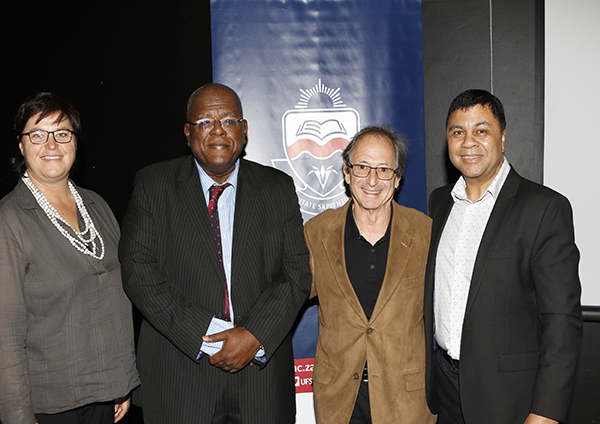
From left; Prof Corli Witthuhn, Vice-Rector: Research; former Rector and Vice-
Chancellor of the UFS, Prof Jonathan Jansen; Prof Michael Levitt, and
Prof Francis Petersen at the celebration lecture at the UFS.
Photo: Johan Roux
One of the critical issues that emerged from the South African student protests during 2015 and 2016 was a demand for the decolonisation of university curriculums.
A senior professor at the Stellenbosch University, Prof Jonathan Jansen, said the number of people, including academics, who joined the cause without adequately interrogating the language of this protest, was astonishing. “The role of social scientists is to investigate new ideas … when something is presented to the world as truth.” Prof Jansen was speaking during a celebration lecture at the University of the Free State in Bloemfontein on 15 November 2017.
Large amount of knowledge not African
He said the accusation is correct to a limited degree. “The objection, in essence, is against the centring of Western, and especially European knowledge, in institutional curricula.” There is no doubt that most of what constitutes curriculum knowledge in South African universities, and in universities around the world, derive from the West. “The major theories and theorists, the methodologists and methods are disproportionally situated outside of the developing world,” Prof Jansen said.
The dilemma is, how will South Africa and the continent change the locus of knowledge production, considering the deteriorating state of public universities? “In the absence of vibrant, original, and creative knowledge production systems in Africa and South Africa, where will this African-centred or African-led curriculum theory come from,” Jansen asked. He says the re-centring of a curriculum needs scholars with significant post-doctoral experiences that are rooted in the study of education and endowed with the critical independence of thought. “South Africa's universities are not places where scholars can think. South African universities’ current primary occupation is security and police dogs,” Prof Jansen said.
Collaboration between African and Western scholars
“Despite the challenges, not everything was stuck in the past,” Prof Jansen said. South African scholars now lead major research programmes in the country intellectually. The common thread between these projects is that the content is African in the subjects of study, and the work reflects collaboration with academics in the rest of the world. These research projects attract postgraduate students from the West, and the research increasingly affects curriculum transformations across university departments. There is also an ongoing shift in the locus of authority for knowledge production within leading universities in South Africa. Prof Jansen feels a significant problem that is being ignored in the curriculum debate, is the concern about the knowledge of the future. How does South Africa prepare its young for the opportunities provided by the groundswell of technological innovation? “In other parts of the world, school children are learning coding, artificial intelligence, and automation on a large scale. They are introduced to neuroscience and applied mathematics,” he said.
Prof Jansen said, in contrast, in South Africa the debate focuses on the merits of mathematics literacy, and what to do with dead people’s statues.